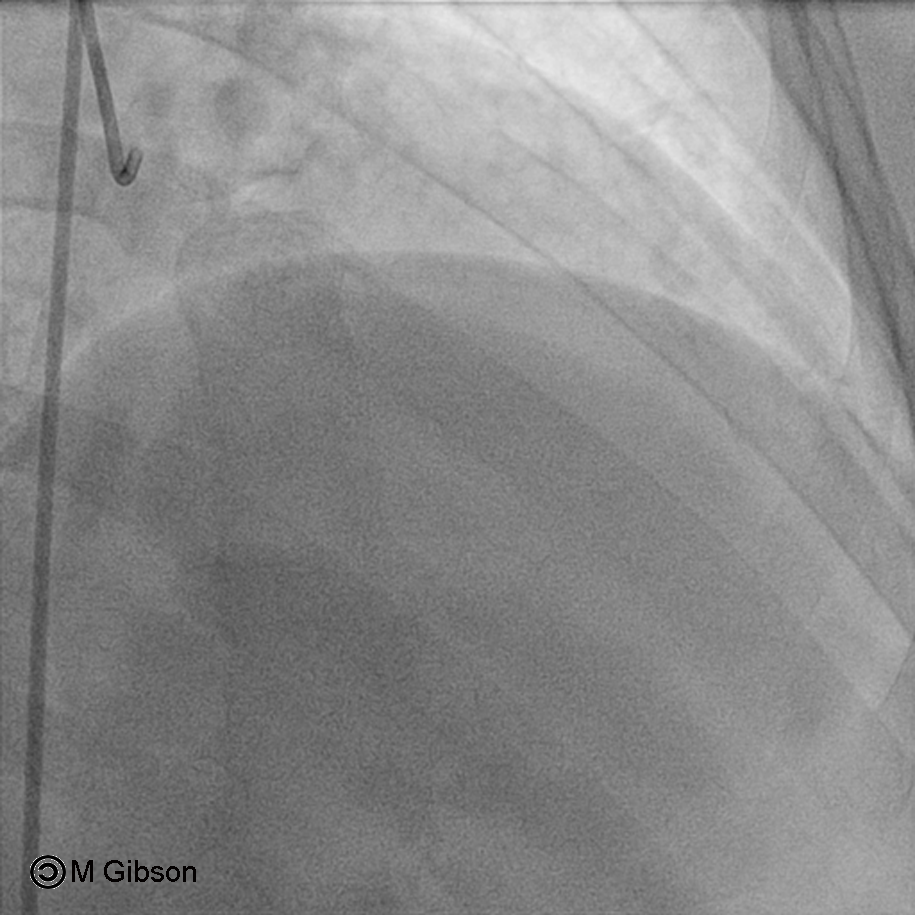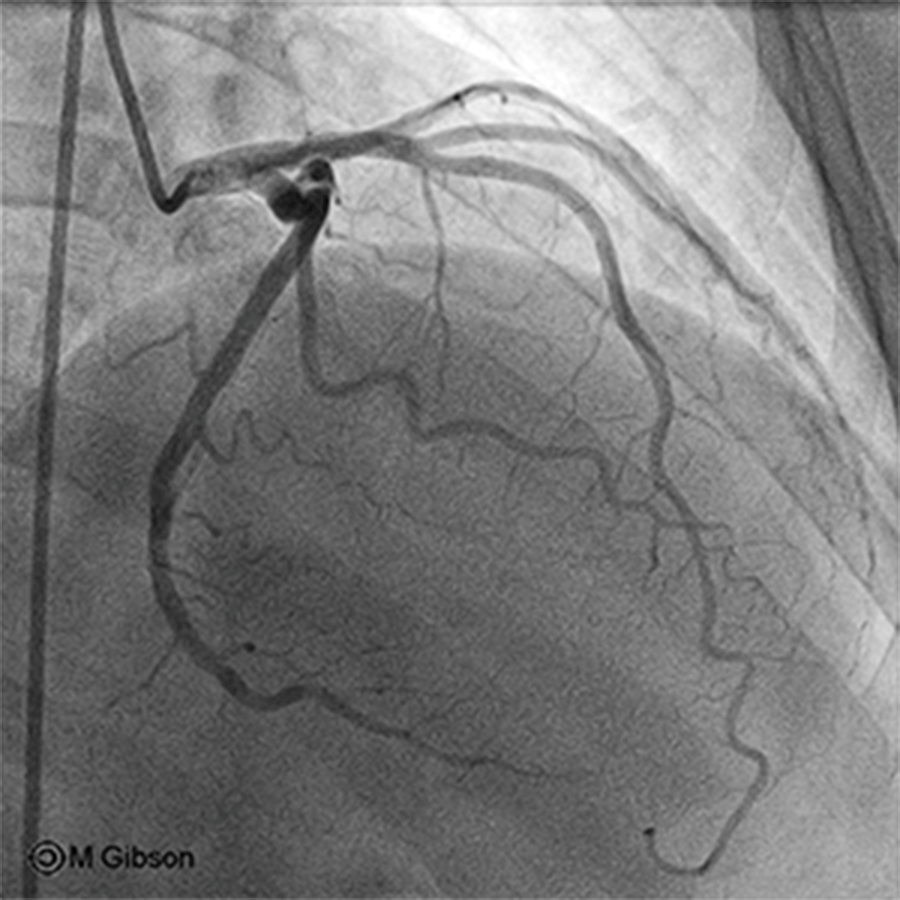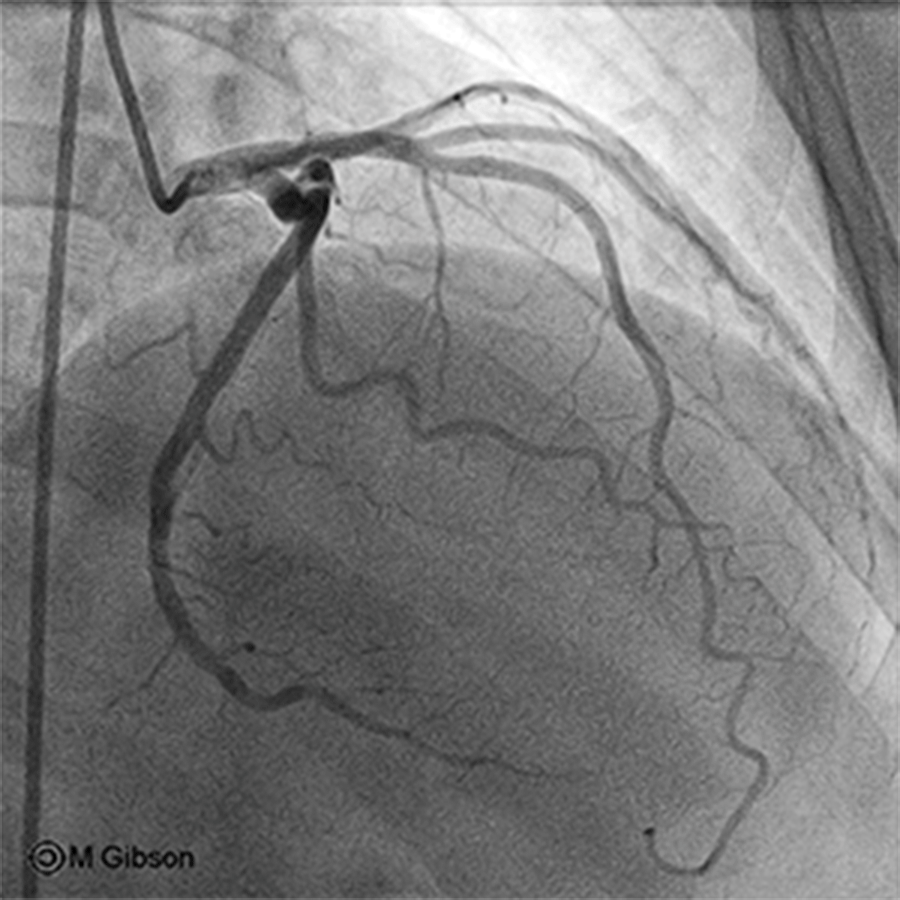Left circumflex artery: Difference between revisions
No edit summary |
|||
| (15 intermediate revisions by 3 users not shown) | |||
| Line 1: | Line 1: | ||
__NOTOC__ | __NOTOC__ | ||
{{Coronary angiography2}} | |||
{{CMG}} | {{CMG}} | ||
{{SK}} Circumflex artery; circumflex branch of the left coronary artery; Cx; LCx; left circumflex artery | |||
==Overview== | ==Overview== | ||
The circumflex artery curves to the left around the [[heart]] within the [[coronary sulcus]], giving rise to one or more diagonal or [[left marginal arteries]] (also called obtuse marginal branches (OM)) as it curves toward the posterior surface of the heart. It helps form the posterior left ventricular branch or posterolateral artery. The circumflex artery ends at the point where it joins to form to the [[posterior interventricular artery]] in ten percent of all cases, which lies in the posterior [[interventricular sulcus]]. In the other 90% of all cases the posterior interventricular artery comes out of the right coronary artery. | The circumflex artery curves to the left around the [[heart]] within the [[coronary sulcus]], giving rise to one or more diagonal or [[left marginal arteries]] (also called obtuse marginal branches (OM)) as it curves toward the posterior surface of the heart. It helps form the posterior left ventricular branch or posterolateral artery. The circumflex artery ends at the point where it joins to form to the [[posterior interventricular artery]] in ten percent of all cases, which lies in the posterior [[interventricular sulcus]]. In the other 90% of all cases the posterior interventricular artery comes out of the right coronary artery. | ||
==CX Branches== | ==CX Branches== | ||
===Marginal Arteries=== | |||
===Marginal | |||
Marginal arteries are three longest branches off of the circumflex artery supplying the lateral wall of the left ventricle, unless there is a large branching vessel which dominates the lateral left ventricular wall. When a large dominating artery is present, it is called an obtuse marginal. These marginal arteries are numbered from one (proximal) to three (distal): M1, M2, M3. | Marginal arteries are three longest branches off of the circumflex artery supplying the lateral wall of the left ventricle, unless there is a large branching vessel which dominates the lateral left ventricular wall. When a large dominating artery is present, it is called an obtuse marginal. These marginal arteries are numbered from one (proximal) to three (distal): M1, M2, M3. | ||
===Obtuse | ===Obtuse Marginal Arteries=== | ||
Obtuse marginal artery is a large branching artery which dominates the lateral left ventricular wall. An obtuse marginal is composed of anterior and posterior branches which share a common trunk. The anterior and posterior branches may substitute for the first and second marginal branches (or the second and third marginal branches), although a first (or third) marginal is permitted if present. No more than a single obtuse marginal may be present. An obtuse marginal is further specified as OM1, OM2, or OM3 depending on where the trunk arises compared to the usual origins of the first, second and third marginal arteries. | Obtuse marginal artery is a large branching artery which dominates the lateral left ventricular wall. An obtuse marginal is composed of anterior and posterior branches which share a common trunk. The anterior and posterior branches may substitute for the first and second marginal branches (or the second and third marginal branches), although a first (or third) marginal is permitted if present. No more than a single obtuse marginal may be present. An obtuse marginal is further specified as OM1, OM2, or OM3 depending on where the trunk arises compared to the usual origins of the first, second and third marginal arteries. | ||
===Obtuse | ===Obtuse Marginal Trunk=== | ||
Obtuse marginal trunk is the common trunk of an artery connecting the anterior and posterior branches of an obtuse marginal to the circumflex. | Obtuse marginal trunk is the common trunk of an artery connecting the anterior and posterior branches of an obtuse marginal to the circumflex. | ||
* Anterior branch of the obtuse marginal artery (OA) | * Anterior branch of the obtuse marginal artery (OA) | ||
| Line 53: | Line 24: | ||
: It is a large branching vessel which dominates the lateral left ventricular wall. | : It is a large branching vessel which dominates the lateral left ventricular wall. | ||
Shown below are an animated image and a static image depicting the CX . The first image is an angiograhic view of the left system, the image at the right illustrates the marginal branches of the CX . | |||
[[Image:LAD02.gif|300px|Angiographic view of the LAD and the LCX]][[Image:CX-with-branches-only.gif|300px|The branches of the CX]] | |||
<span style="font-size:85%">LAD= Left anterior descending artery; M2, M3 = Marginal arteries ; OM1= Obtuse marginal artery.</span> | |||
==CX Segments== | |||
The CX can be divided into three main segments (C1, C2, C3 and C4) according to the origin of the marginal arteries. The CX segments are the following: | |||
===Proximal Circumflex Artery=== | |||
The proximal circumflex artery is referred to as C1. It Extends from the origin of the circumflex off of the left main to the origin of the first marginal or obtuse marginal branch. When a second obtuse marginal is present and the first marginal is absent, the C1- C2 transition is defined as halfway from the origin of the circumflex to the origin of the second obtuse marginal. | |||
===Mid Circumflex Artery=== | |||
The mid circumflex artery is referred to as C2. It Extends from the origin of the first marginal or obtuse marginal branch to the origin of the second marginal or obtuse marginal branch. When a second obtuse marginal is present and the first marginal is absent, the C1- C2 transition is defined as halfway from the origin of the circumflex to the origin of the second obtuse marginal. When a first obtuse marginal is present and the second marginal is absent, the C2- C3 transition is defined to be halfway from the first obtuse marginal to the end of C3. | |||
===Distal Circumflex Artery=== | |||
The distal circumflex artery is referred to C3. It Extends from the origin of the second marginal or obtuse marginal to the termination of the circumflex artery in large right dominant anatomy or to the origin of the circumflex posterior branch (CP) in all other dominance. | |||
===Left Posterior Descending Artery=== | |||
Shown below are an animated image and a static image depicting the CX. The first image is an angiograhic view of the left system, the image at the right illustrates the different segments of the CX (C1, C2, and C3). | |||
[[Image:LAD02.gif|300px|Angiographic view of the LAD and the LCX]][[File:CX-branches-and-segments.gif|300px|The marginal branches of the CX as well as the different segments of the CX]] | |||
<span style="font-size:85%">LAD= Left anterior descending artery; C1= Proximal circumflex artery; C2= Mid circumflex artery; C3= Distal circumflex artery; M2, M3 = Marginal arteries ; OM1= Obtuse marginal artery.</span> | |||
==Cardiac supply== | ==Cardiac supply== | ||
The LCX supplies the posterolateral [[left ventricle]] and the anterolateral [[papillary muscle]]. It also supplies the [[sinoatrial nodal artery]] in 38% of people. It supplies 15-25% of the [[left ventricle]] in right-dominant systems. If the coronary anatomy is left-dominant, the LCX supplies 40-50% of the left ventricle. | The LCX supplies the posterolateral [[left ventricle]] and the anterolateral [[papillary muscle]]. It also supplies the [[sinoatrial nodal artery]] in 38% of people. It supplies 15-25% of the [[left ventricle]] in right-dominant systems. If the coronary anatomy is left-dominant, the LCX supplies 40-50% of the left ventricle. | ||
==Additional Images== | |||
== | ==References== | ||
{{Reflist|2}} | |||
{{Arteries of chest}} | {{Arteries of chest}} | ||
{{Coronary Angiography}} | |||
[[Category:Cardiology]] | |||
[[Category:Anatomy]] | |||
[[Category:Angiopedia]] | |||
[[Category:Arteries]] | |||
[[Category:Cardiac anatomy]] | |||
[[Category:Cardiology]] | |||
[[Category:Cardiovascular system]] | |||
[[Category:Up-To-Date]] | |||
[[Category:Up-To-Date Cardiology]] | |||
{{WikiDoc Help Menu}} | |||
{{WikiDoc Sources}} | |||
Latest revision as of 15:10, 13 November 2013
|
Coronary Angiography | |
|
General Principles | |
|---|---|
|
Anatomy & Projection Angles | |
|
Normal Anatomy | |
|
Anatomic Variants | |
|
Projection Angles | |
|
Epicardial Flow & Myocardial Perfusion | |
|
Epicardial Flow | |
|
Myocardial Perfusion | |
|
Lesion Complexity | |
|
ACC/AHA Lesion-Specific Classification of the Primary Target Stenosis | |
|
Lesion Morphology | |
Editor-In-Chief: C. Michael Gibson, M.S., M.D. [1]
Synonyms and keywords: Circumflex artery; circumflex branch of the left coronary artery; Cx; LCx; left circumflex artery
Overview
The circumflex artery curves to the left around the heart within the coronary sulcus, giving rise to one or more diagonal or left marginal arteries (also called obtuse marginal branches (OM)) as it curves toward the posterior surface of the heart. It helps form the posterior left ventricular branch or posterolateral artery. The circumflex artery ends at the point where it joins to form to the posterior interventricular artery in ten percent of all cases, which lies in the posterior interventricular sulcus. In the other 90% of all cases the posterior interventricular artery comes out of the right coronary artery.
CX Branches
Marginal Arteries
Marginal arteries are three longest branches off of the circumflex artery supplying the lateral wall of the left ventricle, unless there is a large branching vessel which dominates the lateral left ventricular wall. When a large dominating artery is present, it is called an obtuse marginal. These marginal arteries are numbered from one (proximal) to three (distal): M1, M2, M3.
Obtuse Marginal Arteries
Obtuse marginal artery is a large branching artery which dominates the lateral left ventricular wall. An obtuse marginal is composed of anterior and posterior branches which share a common trunk. The anterior and posterior branches may substitute for the first and second marginal branches (or the second and third marginal branches), although a first (or third) marginal is permitted if present. No more than a single obtuse marginal may be present. An obtuse marginal is further specified as OM1, OM2, or OM3 depending on where the trunk arises compared to the usual origins of the first, second and third marginal arteries.
Obtuse Marginal Trunk
Obtuse marginal trunk is the common trunk of an artery connecting the anterior and posterior branches of an obtuse marginal to the circumflex.
- Anterior branch of the obtuse marginal artery (OA)
- It is a large branching vessel which dominates the lateral left ventricular wall. As no more than a single obtuse marginal may be present, the OA is not numbered.
- Posterior branch of the obtuse marginal artery (OT)
- It is a large branching vessel which dominates the lateral left ventricular wall.
Shown below are an animated image and a static image depicting the CX . The first image is an angiograhic view of the left system, the image at the right illustrates the marginal branches of the CX .
LAD= Left anterior descending artery; M2, M3 = Marginal arteries ; OM1= Obtuse marginal artery.
CX Segments
The CX can be divided into three main segments (C1, C2, C3 and C4) according to the origin of the marginal arteries. The CX segments are the following:
Proximal Circumflex Artery
The proximal circumflex artery is referred to as C1. It Extends from the origin of the circumflex off of the left main to the origin of the first marginal or obtuse marginal branch. When a second obtuse marginal is present and the first marginal is absent, the C1- C2 transition is defined as halfway from the origin of the circumflex to the origin of the second obtuse marginal.
Mid Circumflex Artery
The mid circumflex artery is referred to as C2. It Extends from the origin of the first marginal or obtuse marginal branch to the origin of the second marginal or obtuse marginal branch. When a second obtuse marginal is present and the first marginal is absent, the C1- C2 transition is defined as halfway from the origin of the circumflex to the origin of the second obtuse marginal. When a first obtuse marginal is present and the second marginal is absent, the C2- C3 transition is defined to be halfway from the first obtuse marginal to the end of C3.
Distal Circumflex Artery
The distal circumflex artery is referred to C3. It Extends from the origin of the second marginal or obtuse marginal to the termination of the circumflex artery in large right dominant anatomy or to the origin of the circumflex posterior branch (CP) in all other dominance.
Left Posterior Descending Artery
Shown below are an animated image and a static image depicting the CX. The first image is an angiograhic view of the left system, the image at the right illustrates the different segments of the CX (C1, C2, and C3).
LAD= Left anterior descending artery; C1= Proximal circumflex artery; C2= Mid circumflex artery; C3= Distal circumflex artery; M2, M3 = Marginal arteries ; OM1= Obtuse marginal artery.
Cardiac supply
The LCX supplies the posterolateral left ventricle and the anterolateral papillary muscle. It also supplies the sinoatrial nodal artery in 38% of people. It supplies 15-25% of the left ventricle in right-dominant systems. If the coronary anatomy is left-dominant, the LCX supplies 40-50% of the left ventricle.


